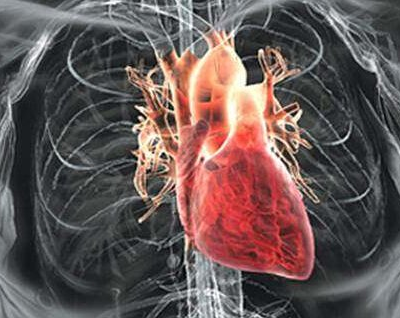We dealt with the lungs when we went from the right ventricle,
从右心室出来,之后跟肺部有关
went to the lungs in a loop, back to the left atrium.
完成肺部循环,血液进入左心房
Now we're in the left ventricle.
现在是在左心室
We pump into the aorta.
然后血液进入大动脉
Now this is to go to the rest of the body.
然后将血液输送到身体各处
This is an artery, a non-pulmonary artery-- and it is oxygenated.
这是一条输送含氧血的动脉,但不是肺动脉
So when we're dealing with non-pulmonary arteries, we're oxygenated,
这是一条输送含氧血的动脉,但不是肺动脉
but a pulmonary artery has no oxygen.
实际上,肺动脉是几乎不含氧气的
It's going away from the heart to get the oxygen.
肺动脉中的血液远离心脏,就是为了补充氧气
Pulmonary vein comes from the lungs to the heart with oxygen,
肺静脉中流向心脏的血液携带氧气
but the rest of the veins go to the heart without oxygen
而其他流向心脏的血液都是几乎不含氧气的
because they want to go into that loop on the pulmonary loop right there.
因为这些静脉的作用就是将血液输送到心脏,再完成肺循环
So I'll leave you there.
好,我们就介绍到这里

Hopefully that gives-- actually, let's go back to that first diagram.
现在我们重新看第一个图解
I think you have a sense of how the heart is dealing,
大家应该能明白心脏的工作原理了
but let's go look at the rest of the body and just get a sense of things.
下面我们看一下身体各处,看一下工作机理
You can look this up on Wikipedia if you like.
这个图大家在维基百科上可以找到
All of these different branching points have different names to them,
这些不同点都有不同名字
but you can see right here you have kind of a branching off, a little bit below the heart.
大家看心脏往下的位置,这里有分支
This is actually the celiac trunk.
这是腹腔动脉
Celiac, if I remember correctly, kind of refers to an abdomen.
celiac的意思就是腹腔,跟腹部有关的
So this blood that-- your hepatic artery.
这条血管就是肝动脉
Hepatic deals with the liver.
hepatic指跟肝脏有关的
Your hepatic artery branches off of this to get blood flow to the liver.
之后肝动脉产生分支为肝脏提供血液
It also gives blood flow to your stomach so it's very important in digestion and all that.
同时为胃部提供血液,所以这里的血管对消化功能至关重要
And then let's say this is the hepatic trunk.
假设这是肝动脉
Your liver is sitting like that.
肝脏差不多是这样
Hepatic trunk-- it delivers oxygen to the liver.
肝动脉为肝脏输送氧气
The liver is doing respiration.
肝脏要做呼吸作用
It takes up the oxygen and then it gives up carbon dioxide.
需要消耗氧气,产生二氧化碳
So it becomes de-oxygenated and then it flows back in and to the inferior vena cava, into the vein.
这样血液变成缺氧血,然后流回下腔静脉
I want to make it clear-- it's a loop. It's a big loop.
我标清楚,这是一个大循环
The blood doesn't just flow out someplace and then come back someplace else.
并不是说血液随便流到什么地方,然后又流回来
This is just one big loop.
这些是一个循环
And if you want to know at any given point in time,
如果大家要细究的话
depending on your size, there's about five liters of blood.
根据大家体型不同,血液大约有5升
And I looked it up-- it takes the average red blood cell to go from one point in the circulatory system
我查了一下,血红细胞完成一整个循环
and go through the whole system and come back, 20 seconds.
平均只需要20秒
That's an average because you can imagine there might be some red blood cells that get stuck someplace
之所以说是平均值,因为可能在某些地方
and take a little bit more time and some go through the completely perfect route.
血红细胞运动受阻,那么时间消耗多,有的地方畅通无阻,那么时间消耗少
Actually, the 20 seconds might be closer to the perfect route.
20秒可能是血管畅通的情况
I've never timed it myself.
我没有计时过
But it's an interesting thing to look at and to think about what's connected to what.
好,介绍的这些应该能给大家一点系统的认知,知道彼此的联系
You have these these arteries up here that
这里的这些动脉
they first branch off the arteries up here from the aorta into the head and the neck and the arm arteries
大动脉的各种分支进入头部,颈部,胳膊
and then later they go down
然后下行
and they flow blood to the rest of the body.
送至身体各处
So anyway, this is a pretty interesting idea.
这个内容还是很有意思的
In the next video, what I want to do is talk about, how does the hemoglobin know when to dump the oxygen?
下集视频里,我们将探讨,血红蛋白如何“决定”释放氧气的时间
Or even better, where to dump the oxygen-- because maybe I'm running
或者说,释放氧气的位置,假设在跑步
so I need a lot of oxygen in the capillaries around my thigh muscles.
腿部肌肉的毛细血管可能需要大量氧气
I don't need them necessarily in my hands.
而手并不需要太多氧气
How does the body optimize where the oxygen is actually delivering?
身体如何优化氧气的输送情况呢?
It's actually fascinating.
这个思路还是很有吸引力的












